Soil Moisture Dynamics in Response to Precipitation and Thinning in a Semi-Dry Forest in Northern Mexico
Abstract
:1. Introduction
2. Materials and Methods
2.1. Study Area
2.2. Micro-Catchments Characterization
2.3. Study Design and Thinning Application
2.4. Rainfall Measurements
2.5. Soil Moisture Monitoring
2.6. Data Analysis
3. Results
3.1. Soil and Vegetation Characteristics
3.2. Precipitation and Soil Moisture before Thinning (2018)
3.3. Precipitation and Soil Moisture after Thinning (2019)
3.4. Statistical Analysis of Soil Moisture before and after Thinning
4. Discussion
4.1. Soil Moisture before Thinning
4.2. Soil Moisture after Thinning
4.3. Management Implications
5. Conclusions
Author Contributions
Funding
Institutional Review Board Statement
Informed Consent Statement
Data Availability Statement
Acknowledgments
Conflicts of Interest
References
- FAO (Organización de las Naciones Unidas para la Agricultura y la Alimentación). Evaluación de los Recursos Forestales Mundiales 2010–Informe Principal, 1st ed.; Estudios FAO: Roma, Italia, 2010; pp. 11–47. [Google Scholar]
- INEGI (Instituto Nacional de Estadística y Geografía). Ecorregiones Terrestres de Mexico, Escala 1:1000000, Mexico. 2008. Available online: http://www.conabio.gob.mx/informacion/gis/layouts/ecort08gw.png (accessed on 20 September 2019).
- SEMARNAT (Secretaría de Medio Ambiente y Recursos Naturales). Atlas de Biodiversidad de Mexico. 2010. Available online: http://gisviewer.semarnat.gob.mx/geointegrador/enlace/atlas2010/atlas_biodiversidad.pdf (accessed on 26 September 2019).
- González-Elizondo, S.; González-Elizondo, M.; Tena-Flores, J.A.; Ruacho-González, L.; López-Enríquez, I.L. Vegetación de la sierra madre occidental, Mexico: Una síntesis. Acta Bot. Mex. 2012, 100, 351–403. [Google Scholar] [CrossRef] [Green Version]
- CONAGUA (Comisión Nacional del Agua). Normales Climatológicas de Mexico por Estado. 2020. Available online: https://smn.conagua.gob.mx/es/informacion-climatologica-por-estado?estado=chih (accessed on 22 April 2020).
- Sun, F.; Lüa, Y.; Wang, J.; Hua, J.; Fua, B. Soil moisture dynamics of typical ecosystems in response to precipitation: A monitoring-based analysis of hydrological service in the Qilian Mountains. Catena 2015, 129, 63–75. [Google Scholar] [CrossRef]
- Chow, V.T. Handbook of Applied Hydrology, 1st ed.; McGraw-Hill Book Company: New York, NY, USA, 1964. [Google Scholar]
- Bras, R.L. Hydrology, an Introduction to Hydrologic Science, 1st ed.; Addison-Wesley: Boston, MA, USA, 1990. [Google Scholar]
- He, L.; Ivanov, V.Y.; Bohrer, G.; Thomsen, J.E.; Vogel, C.S.; Moghaddam, M. Temporal dynamics of soil moisture in a northern temperate mixed successional forest after a prescribed intermediate disturbance. Agric. For. Meteorol. 2013, 180, 22–33. [Google Scholar] [CrossRef]
- He, Z.B.; Zhao, W.Z.; Liu, H.; Chang, X.X. The response of soil moisture to rainfall event size in subalpine grassland and meadows in a semi-arid mountain range: A case study in northwestern China’s Qilian Mountains. J. Hydrol. 2012, 421, 183–190. [Google Scholar] [CrossRef]
- Zhu, X.; He, Z.B.; Dua, J.; Chen, L.F.; Lin, P.F.; Li, J. Temporal variability in soil moisture after thinning in semi-arid Picea crassifolia plantations in northwestern China. For. Ecol. Manag. 2017, 401, 273–285. [Google Scholar] [CrossRef]
- Zou, C.B.; Breshears, D.D.; Newman, B.D.; Wilcox, B.P.; Gard, M.O.; Rich, P.M. Soil water dynamics under low-versus high-ponderosa pine tree density: Ecohydrological functioning and restoration implications. Ecohydrology 2008, 4, 309–315. [Google Scholar] [CrossRef]
- Del Campo, A.D.; González-Sanchis, M.; Molina, A.J.; García-Prats, A.; Ceacero, C.J.; Bautista, I. Effectiveness of water-oriented thinning in two semiarid forests: The redistribution of increased net rainfall into soil water, drainage and runoff. For. Ecol. Manag. 2019, 438, 163–175. [Google Scholar] [CrossRef]
- Dung, B.X.; Gomi, T.; Miyata, S.; Sidle, R.C.; Kosugi, K.; Onda, Y. Runoff responses to forest thinning at plot and catchment scales in a headwater catchment draining Japanese cypress forest. J. Hydrol. 2012, 444, 51–62. [Google Scholar] [CrossRef]
- Del campo, A.D.; González-Sanchis, M.; Lidón, A.; Ceacero, C.J.; García-Prats, A. Rainfall partitioning after thinning in two low-biomass semiarid forests: Impact of meteorological variables and forest structure on the effectiveness of water-oriented treatments. J. Hydrol. 2018, 556, 74–86. [Google Scholar] [CrossRef]
- Baker, M.B. Effects of ponderosa pine treatments on water yield in Arizona. Water Resour. Res. 1986, 22, 67–73. [Google Scholar] [CrossRef]
- Feeney, S.R.; Kolb, T.E.; Covington, W.W.; Wagner, M.R. Influence of thinning and burning restoration treatments on presettlement ponderosa pines at the Gus Pearson Natural Area. Can. J. For. Res. 1998, 28, 1295–1306. [Google Scholar] [CrossRef]
- Stone, J.E.; Kolb, T.E.; Covington, W.J. Effects of restoration thinning on presettlement Pinus ponderosa in northern Arizona. Restor. Ecol. 1999, 7, 172–182. [Google Scholar] [CrossRef]
- Dunkerley, D. Measuring interception loss and canopy storage in dryland vegetation: A brief review and evaluation of available research strategies. Hydrol. Process. 2000, 14, 669–678. [Google Scholar] [CrossRef]
- Heisler-White, J.L.; Knapp, A.K.; Kelly, E.F. Increasing precipitation event size increases aboveground net primary productivity in a semi-arid grassland. Oecologia 2008, 158, 129–140. [Google Scholar] [CrossRef] [PubMed]
- INEGI (Instituto Nacional de Estadística y Geografía). Síntesis de Información Geográfica del Estado de Chihuahua, 1st ed.; INEGI: Aguascalientes, Mexico, 2003. [Google Scholar]
- FAO (Food and Agriculture Organization of the United Nations). World Reference Base for Soil Resources 2014. International Soil Classification System for Naming Soils and Creating Legends for Soil Maps, 1st ed.; World Soil Resources Reports 106; FAO: Rome, Italy, 2014. [Google Scholar]
- Romahn, C.F.; Ramírez, H. Dendrometría, 2nd ed.; Universidad Autónoma Chapingo: Texcoco, Mexico, 2010; 354p. [Google Scholar]
- Booth, D.T.; Cox, S.E.; Beeryman, R.D. Point sampling digital imagery with SamplePoint. Environ. Monit. Assess. 2006, 123, 97–108. [Google Scholar] [CrossRef] [PubMed]
- Sosa-Pérez, G.; MacDonald, L.H. Effects of closed roads, traffic, and road decommissioning on infiltration and sediment production: A comparative study using rainfall simulations. Catena 2017, 159, 93–105. [Google Scholar] [CrossRef]
- Chen, L.; Yuan, Z.; Shao, H.; Wang, D.; Mu, X. Effects of thinning intensities on soil infiltration and water storage capacity in a Chinese pine-oak mixed forest. Sci. World J. 2014, 268157, 1–7. [Google Scholar] [CrossRef]
- Onset Computer Corporation. HOBO Pendant Event Data Logger (UA-003-64) Manual 2019. Available online: https://www.onsetcomp.com/files/manual_pdfs/9831-I%20MAN-UA-003.pdf (accessed on 16 January 2020).
- USDA (U.S. Department of Agriculture). RIST-Rainfall Intensity Summarization Tool Software; Version 3.94; Agricultural Research Service: Oxford, MS, USA, 2015. [Google Scholar]
- Dunne, T.; Leopold, L.B. Water in Environmental Planning, 1st ed.; W.H. Freeman: New York, NY, USA, 1978. [Google Scholar]
- Spectrum Technologies. SM100 Soil Moisture Sensor Product Manual 2018. Available online: https://www.specmeters.com/assets/1/22/6460_SM1003.pdf (accessed on 16 January 2020).
- Smith, E.P. BACI Design. In Encyclopedia of Environmetrics, 1st ed.; El-Shaarawi, A.H., Piegorsch, W.W., Eds.; John Wiley & Sons Ltd.: Chichester, UK, 2002; pp. 141–148. [Google Scholar]
- SAS (Statistical Analysis Software) Institute. SAS Software; Version 9.3; SAS Inc.: Cary, NC, USA, 2010. [Google Scholar]
- Miller, P.C.; Poole, D.K.; Miller, P.M. The influence of annual precipitation, topography and vegetative cover on soil moisture and summer drought in southern California. Oecologia 1983, 56, 385–391. [Google Scholar] [CrossRef]
- He, Z.B.; Yang, J.J.; Du, J.; Zhao, W.Z.; Liu, H.; Chang, X.X. Spatial variability of canopy interception in a spruce forest of the semiarid mountain regions of China. Agric. For. Meteorol. 2014, 188, 58–63. [Google Scholar] [CrossRef]
- Zhang, Y.F.; Wang, X.P.; Hu, R.; Pan, Y.X. Throughfall and its spatial variability beneath xerophytic shrub canopies within water-limited arid desert ecosystems. J. Hydrol. 2016, 539, 406–416. [Google Scholar] [CrossRef]
- Breshears, D.D.; Nyhan, J.W.; Heil, C.E.; Wilcox, B.P. Effects of woody plants on microclimate in a semiarid woodland: Soil temperature and evaporation in canopy and intercanopy patches. Int. J. Plant. Sci. 1998, 159, 1010–1017. [Google Scholar] [CrossRef]
- Scott, R.L.; Shuttleworth, W.J.; Keefer, T.O.; Warrick, A.W. Modeling multiyear observations of soil moisture recharge in the semiarid American Southwest. Water Resour. Res. 2000, 36, 2233–2247. [Google Scholar] [CrossRef] [Green Version]
- Chang, X.X.; Zhao, W.Z.; He, Z.B. Radial pattern of sap flow and response to microclimate and soil moisture in Qinghai spruce (Picea crassifolia) in the upper Heihe River Basin of arid northwestern China. Agric. For. Meteorol. 2014, 187, 14–21. [Google Scholar] [CrossRef]
- Chen, Y.; Wang, S.; Ren, Z.; Huang, J.; Wang, X.; Liu, S.; Deng, H.; Lin, W. Increased evapotranspiration from land cover changes intensified water crisis in an arid river basin in northwest China. J. Hydrol. 2019, 574, 383–397. [Google Scholar] [CrossRef]
- Návar, J. Fitting rainfall interception models to forest ecosystems of Mexico. J. Hydrol. 2017, 548, 458–470. [Google Scholar] [CrossRef]
- Bari, M.A.; Smith, N.; Ruprecht, J.K.; Boyd, B.W. Changes in streamflow components following logging and regeneration in the southern forest of Western Australia. Hydrol. Process. 2015, 10, 447–458. [Google Scholar] [CrossRef]
- Brasil, J.B.; Andrade, E.M.; De Queiroz-Palacio, H.A.; Augusto-Medeiros, P.H.; Neves-Dos Santos, J.C. Characteristics of precipitation and the process of interception in a seasonally dry tropical forest. J. Hydrol. 2018, 19, 307–317. [Google Scholar] [CrossRef]
- Muñoz-Villers, L.E.; Geissert, D.R.; Holwerda, F.; McDonnell, J.J. Factors influencing stream base flow transit times in tropical montane watersheds. Hydrol. Earth Syst. Sc. 2016, 20, 1621–1635. [Google Scholar] [CrossRef] [Green Version]
- Wang, H.; Xu, W.; Zhang, M.; Cui, L.; Yu, X. Effects of forest on mean annual runoff in North China. Pol. J. Environ. Studies 2018, 27, 889–896. [Google Scholar] [CrossRef]
- Zhang, Y.; Wei, H.; Nearing, M.A. Effects of antecedent soil moisture on runoff modeling in small semiarid watersheds of southeastern Arizona. Hydrol. Earth Syst. Sc. 2011, 15, 3171–3179. [Google Scholar] [CrossRef] [Green Version]
- Perry, T.D.; Jones, J.A. Summer streamflow deficits from regenerating Douglas-fir forest in the Pacific Northwest, USA. Ecohydrology 2017, 10, e1790. [Google Scholar] [CrossRef]
- Ariza-Villaverde, A.B.; Pavón-Domínguez, P.; Carmona-Cabezas, R.; Gutiérrez-Ravé, E.; Jiménez-Hornero, F.J. Joint multifractal analysis of air temperature, relative humidity and reference evapotranspiration in the middle zone of the Guadalquivir river valley. Agric. For. Meteorol. 2019, 278, 107657. [Google Scholar] [CrossRef]
- Gebhardt, T.; Häberleb, K.; Matyssekb, R.; Schulzc, C.; Ammer, C. The more, the better? Water relations of Norway spruce stands after progressive thinning. Agric. For. Meteorol. 2014, 197, 235–243. [Google Scholar] [CrossRef]
- Schrumpf, M.; Axmacher, J.C.; Zech, W.; Lyaruu, H.V.M. Net precipitation and soil water dynamics in clearings, old secondary and old-growth forests in the montane rain forest belt of Mount Kilimanjaro, Tanzania. Hydrol. Process. 2011, 25, 418–428. [Google Scholar] [CrossRef]
- Fedorová, B.; Kadavy, J.; Adamec, Z.; Knott, R.; Kucera, A.; Kneifl, M.; Drápela, K. Effect of thinning and reduced throughfall in young coppice dominated by Quercus petraea (Matt.) Liebl. and Carpinus betulus L. Austrian J. For. Sci. 2018, 135, 1–17. [Google Scholar]
- Lozano-Parra, J.; Schnabel, S.; Ceballos-Barbancho, A. The role of vegetation covers on soil wetting processes at rainfall event scale in scattered tree woodland of Mediterranean climate. J. Hydrol. 2015, 529, 951–961. [Google Scholar] [CrossRef]
- Cantón, Y.; Solé-Benet, A.; Domingo, F. Temporal and spatial patterns of soil moisture in semiarid badlands of SE Spain. J. Hydrol. 2004, 285, 199–214. [Google Scholar] [CrossRef]
- Carter, M.C.; Dean, T.J.; Wang, Z.; Newbold, R.A. Impacts of harvesting and postharvest treatments on soil bulk density, soil strength, and early growth of Pinus taeda in the Gulf Coastal Plain: A long-term soil productivity affiliated study. Can. J. For. Res. 2006, 36, 601–614. [Google Scholar] [CrossRef]
- Tarpey, R.A.; Jurgensen, M.F.; Palik, B.J.; Kolka, R.K. The long-term effects of silvicultural thinning and partial cutting on soil compaction in red pine (Pinus resinosa Ait.) and northern hardwood stands in the northern Great Lakes Region of the United States. Can. J. Soil Sci. 2008, 88, 849–857. [Google Scholar] [CrossRef]
- Wall, A. Risk analysis of effects of whole-tree harvesting on site productivity. For. Ecol. Manag. 2012, 282, 175–184. [Google Scholar] [CrossRef]
- Keesstra, S.D.; Mol, G.; De Leeuw, J.; Okx, J.; Molenaar, C.; De Cleen, M.; Visser, S. Soil related sustainable development goals: Four concepts to make land degradation neutrality and restoration work. Land 2018, 7, 133. [Google Scholar] [CrossRef] [Green Version]
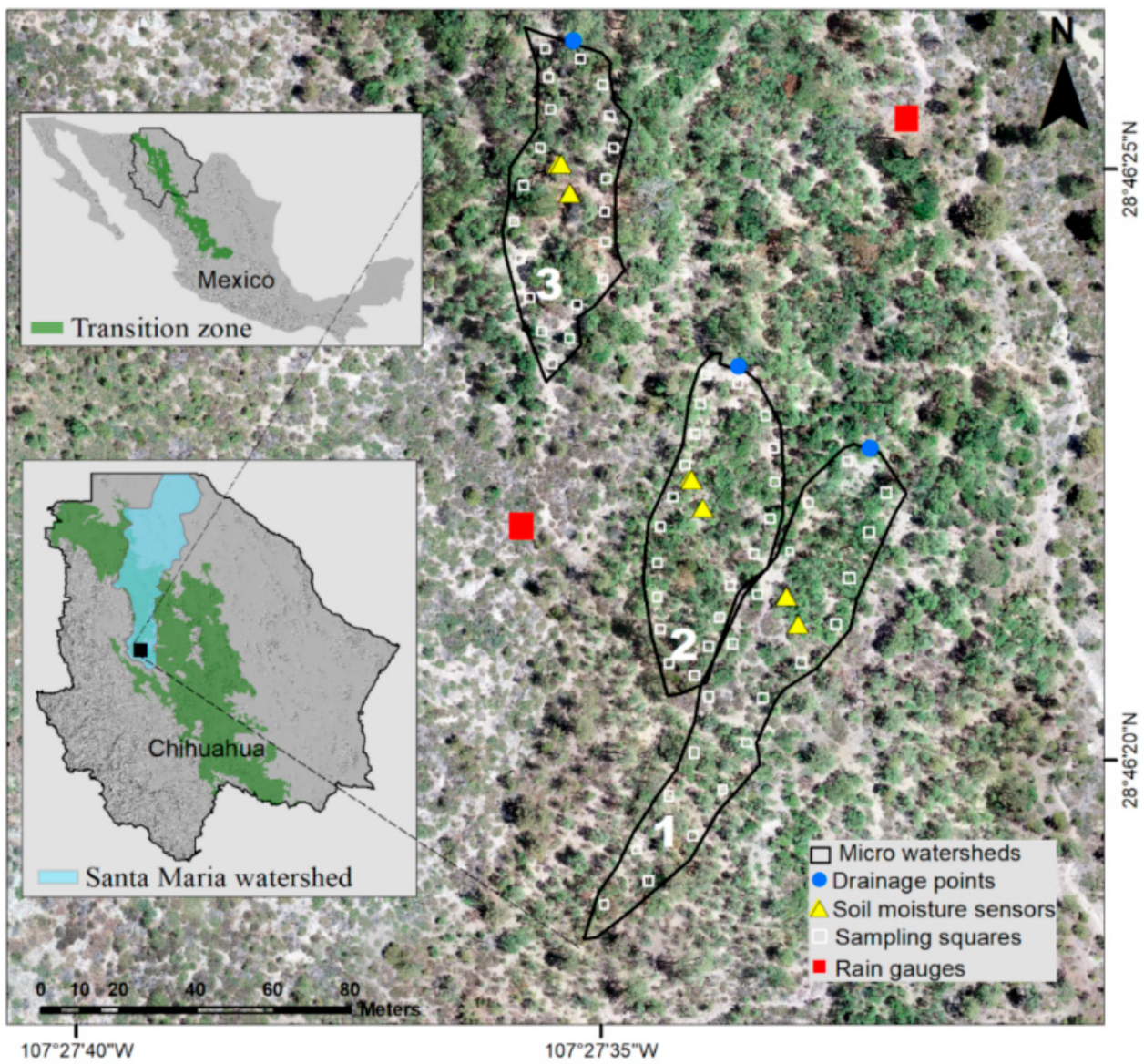

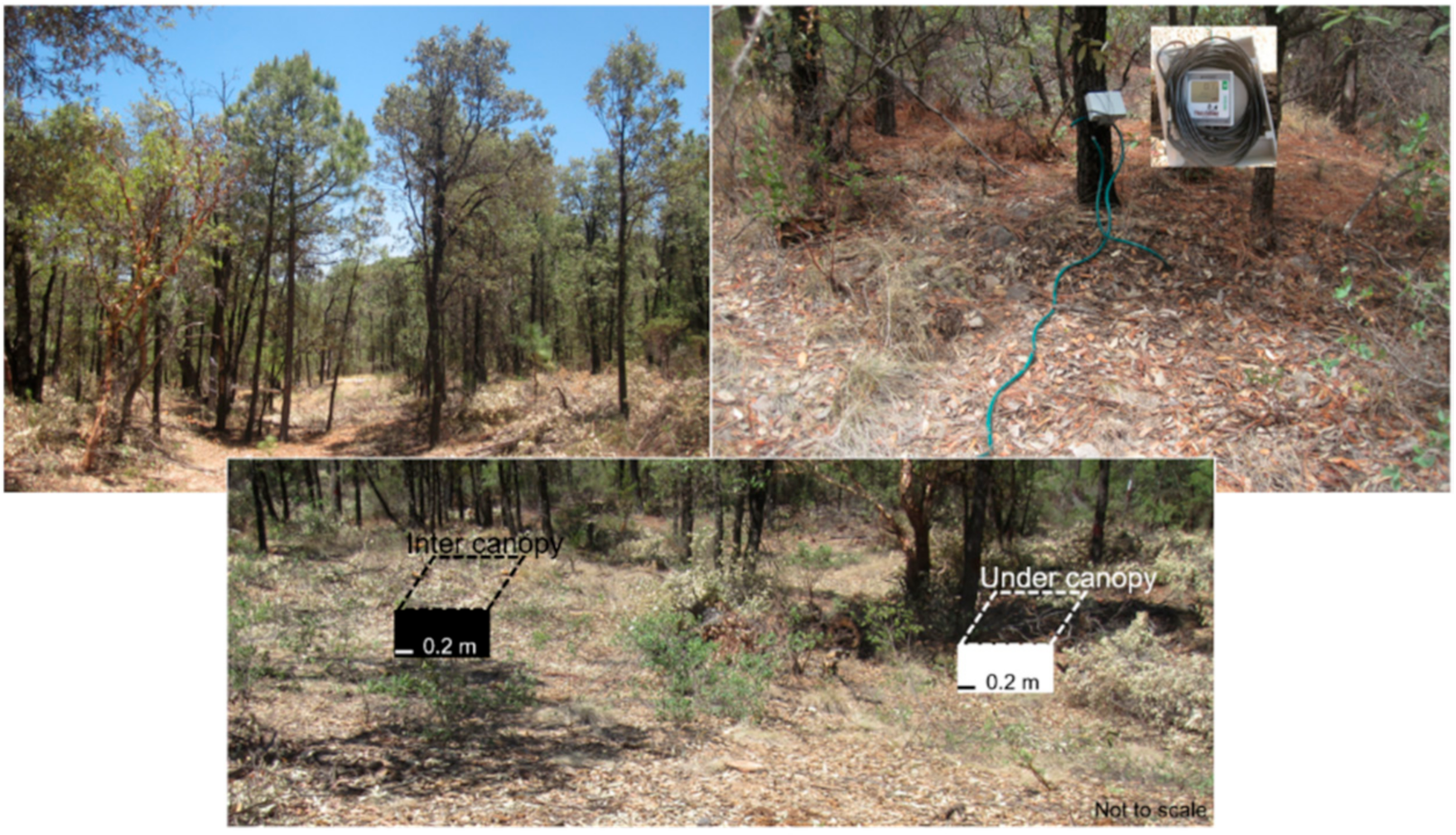




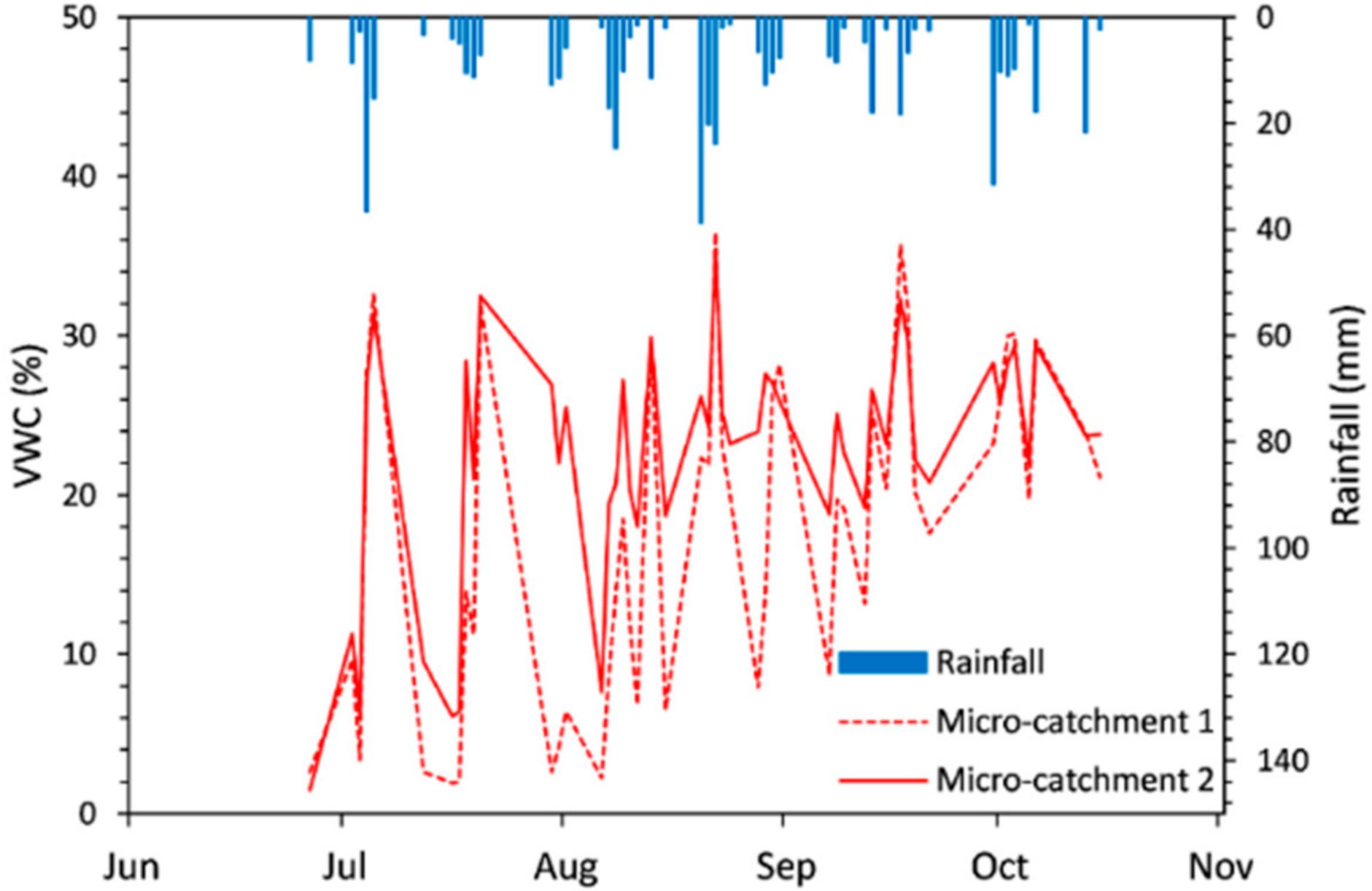
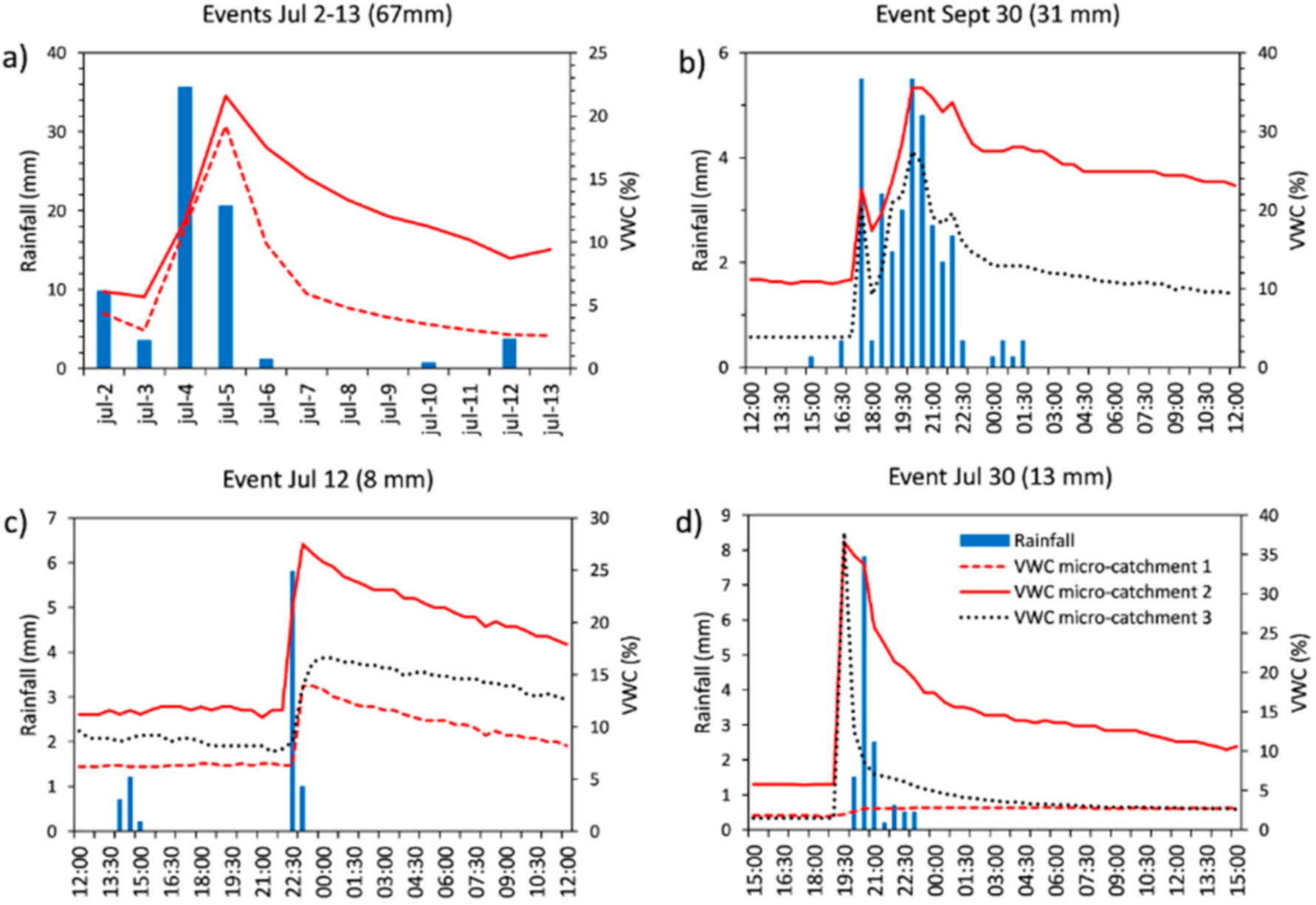
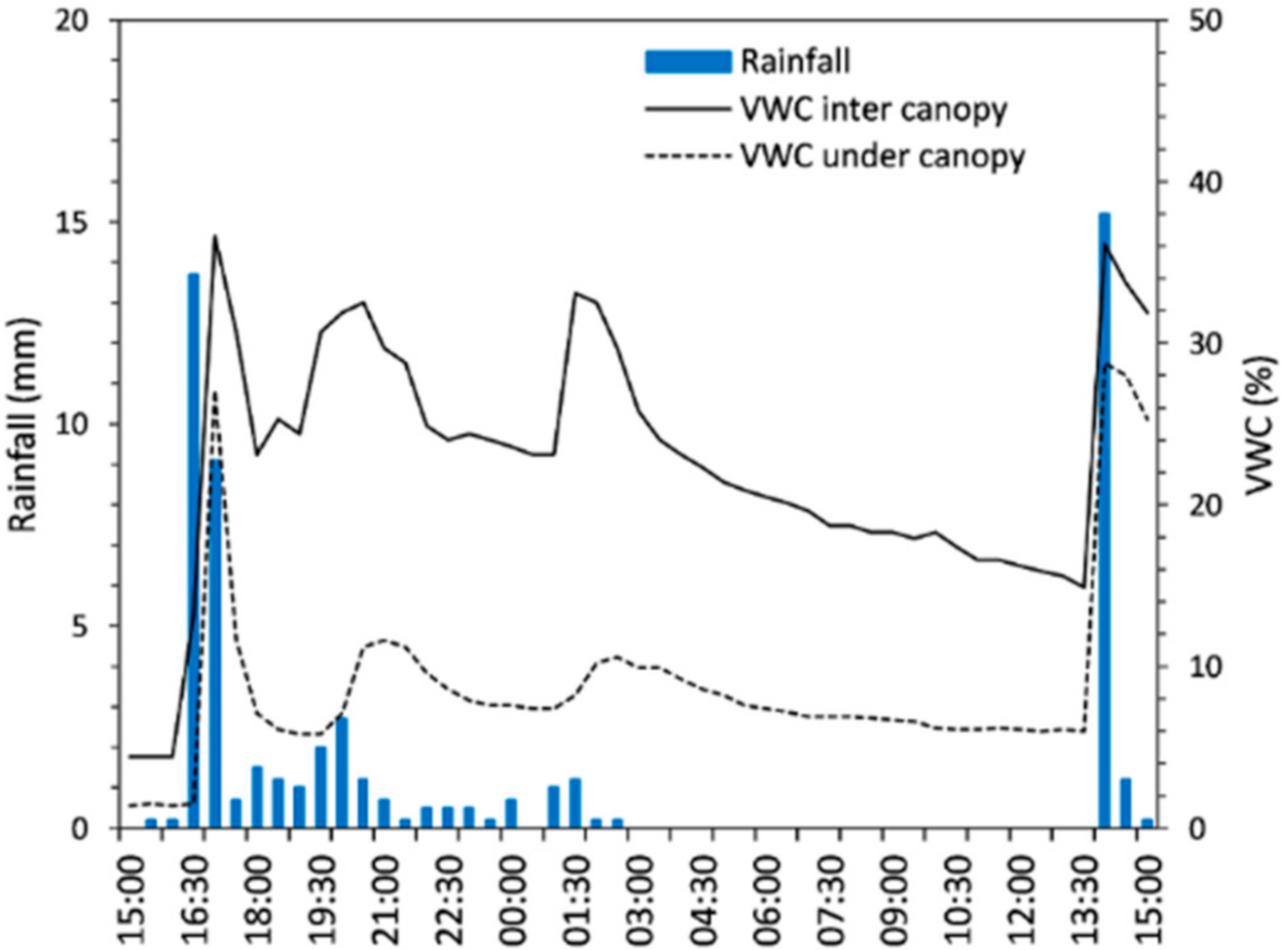
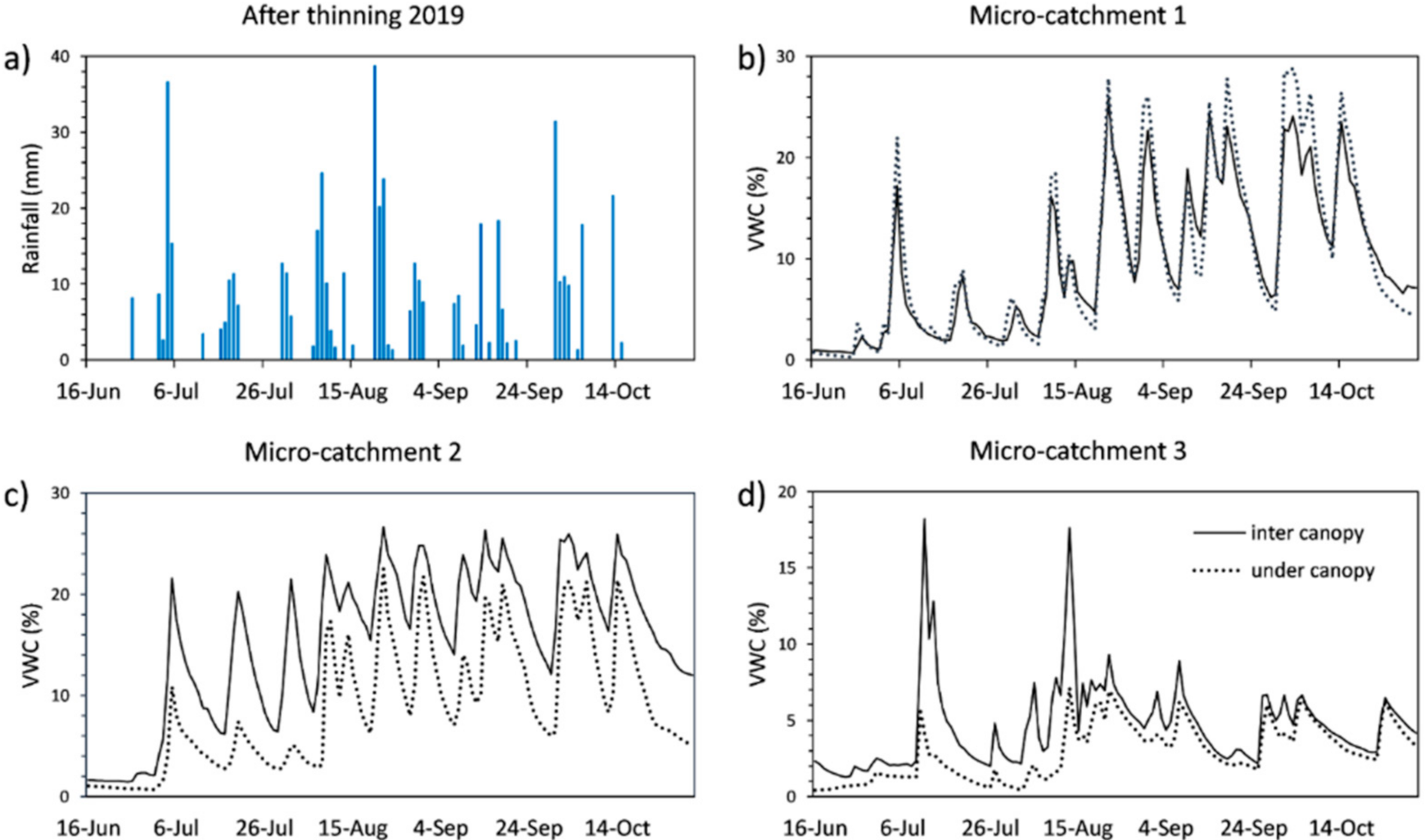
| Factor | Variable | Unit |
|---|---|---|
| Precipitation | Rainfall depth | mm |
| Rainfall event duration | h | |
| Maximum 30-min rainfall intensity | mm h−1 | |
| Antecedent precipitation index | mm | |
| Soil moisture | Maximum VWC inter canopy * | % VWC |
| Average VWC inter canopy * | ||
| Maximum VWC under canopy * | ||
| Average VWC under canopy * |
| Before Thinning (2018) | |||
|---|---|---|---|
| Micro-Catchment | |||
| Characteristic | 1 | 2 | 3 |
| Tree density (trees ha−1) | 2311 | 2172 | 2147 |
| Basal area (m2 ha−1) | 22.4 | 21.9 | 26.9 |
| Canopy cover (%) | 110.5 | 89.7 | 106.4 |
| Litter (%) | 60.4 | 69.7 | 76.4 |
| Herbaceous vegetation (%) | 16.0 | 18.4 | 11.0 |
| Bare soil (%) | 23.6 | 11.9 | 12.6 |
| Slope (%) | 10.3 | 11.5 | 12.0 |
| Surface roughness | 0.947 | 0.945 | 0.954 |
| Soil depth (m) | 0.29 | 0.48 | 0.47 |
| Soil bulk density (g cm−3) | 1.03 | 1.10 | 1.27 |
| After Thinning (2019) | |||
| Percentage of Standing Trees by Catchment | |||
| Characteristic | 1 = 100% | 2 = 20% | 3 = 60% |
| Tree density (trees ha−1) | 2311 | 434 | 1290 |
| Basal area (m2 ha−1) | 22.4 | 6.6 | 17.2 |
| Canopy cover (%) | 110.5 | 19.1 | 61.5 |
| Date | R (mm) | D (h) | I30 (mm h−1) | API (mm) | VWC (%) | |||||
|---|---|---|---|---|---|---|---|---|---|---|
| Catchment 1 | Catchment 2 | Catchment 3 | ||||||||
| Max | Avg | Max | Avg | Max | Avg | |||||
| Large rainfall events | ||||||||||
| Sept 26 | 59.3 | 6.6 | 49.8 | 72.0 | 44.3 | 28.4 | 43.1 | 24.5 | 49.2 | 16.9 |
| Oct 4 | 36.8 | 5.1 | 29.0 | 73.8 | 43.1 | 23.1 | 41.4 | 20.4 | 44.9 | 10.2 |
| Oct 23 | 34.2 | 7.3 | 26.9 | 45.5 | 43.1 | 25.3 | - | - | 41.4 | 10.0 |
| Small rainfall events | ||||||||||
| Jun 29 | 4.8 | 2.5 | 4.8 | 18.7 | 2.1 | 1.7 | 2.4 | 2.2 | 2.8 | 2.5 |
| Aug 4 | 10.5 | 9.2 | 9.8 | 26.2 | 27.5 | 6.6 | 13.6 | 5.0 | 24.9 | 7.2 |
| Aug 9 | 6.7 | 10.4 | 2.1 | 34.8 | 7.9 | 5.8 | 11.9 | 8.5 | 6.9 | 7.1 |
| Date | R (mm) | D (h) | I30 (mm h−1) | API (mm) | VWC (%) | |||||
|---|---|---|---|---|---|---|---|---|---|---|
| Catchment 1 | Catchment 2 | Catchment 3 | ||||||||
| Max | Avg | Max | Avg | Max | Avg | |||||
| Large rainfall events | ||||||||||
| Jul 4 | 36.6 | 10.9 | 40.9 | 49.5 | 45.5 | 27.6 | 36.6 | 27.0 | 50.6 | 15.8 |
| Aug 20 | 38.7 | 8.8 | 37.2 | 67.5 | 47.9 | 22.3 | 37.8 | 26.2 | 49.2 | 11.1 |
| Sept 30 | 31.5 | 15.7 | 11.7 | 48.5 | 38.4 | 23.2 | 35.5 | 28.3 | 27.5 | 14.1 |
| Small rainfall events | ||||||||||
| Jul 18 | 10.5 | 1.6 | 17.8 | 35.3 | 29.7 | 13.9 | 37.2 | 28.4 | 48.5 | 18.1 |
| Aug 28 | 6.5 | 0.6 | 12.5 | 59.9 | 8.6 | 7.9 | 24.4 | 24.0 | 20.5 | 15.4 |
| Sept 07 | 7.4 | 3.4 | 5.9 | 41.4 | 13.6 | 8.7 | 23.1 | 18.8 | 18.3 | 9.2 |
| Micro-Catchment 1 | Micro-Catchment 2 | Micro-Catchment 3 | ||||
|---|---|---|---|---|---|---|
| Daily VWC (%) | Daily VWC (%) | Daily VWC (%) | ||||
| Average | Max | Average | Max | Average | Max | |
| Inter canopy | ||||||
| 2018 | 8.6 | 12.5 | 9.7 | 15.9 | 4.6 | 7.9 |
| 2019 | 9.6 | 14.7 | 15.0 | 19.4 | 5.4 | 10.1 |
| df | 137 | 137 | 112 | 112 | 137 | 137 |
| t-Value | −1.9 | −1.7 | −8.8 | −2.8 | −2.5 | −1.8 |
| p-Value | 0.1 | 0.1 | <0.0001 | 0.0069 | 0.01 | 0.07 |
| Under canopy | ||||||
| 2018 | 10.4 | 15.3 | 6.2 | 8.4 | 2.9 | 5.4 |
| 2019 | 10.1 | 15.7 | 8.6 | 11.4 | 4.7 | 7.8 |
| df | 137 | 137 | 112 | 112 | 137 | 137 |
| t-Value | 0.4 | −0.3 | −4.6 | −3.2 | −9.0 | −2.5 |
| p-Value | 0.7 | 0.8 | <0.0001 | 0.0019 | <0.0001 | 0.01 |
Publisher’s Note: MDPI stays neutral with regard to jurisdictional claims in published maps and institutional affiliations. |
© 2021 by the authors. Licensee MDPI, Basel, Switzerland. This article is an open access article distributed under the terms and conditions of the Creative Commons Attribution (CC BY) license (http://creativecommons.org/licenses/by/4.0/).
Share and Cite
Rascón-Ramos, A.E.; Martínez-Salvador, M.; Sosa-Pérez, G.; Villarreal-Guerrero, F.; Pinedo-Alvarez, A.; Santellano-Estrada, E.; Corrales-Lerma, R. Soil Moisture Dynamics in Response to Precipitation and Thinning in a Semi-Dry Forest in Northern Mexico. Water 2021, 13, 105. https://doi.org/10.3390/w13010105
Rascón-Ramos AE, Martínez-Salvador M, Sosa-Pérez G, Villarreal-Guerrero F, Pinedo-Alvarez A, Santellano-Estrada E, Corrales-Lerma R. Soil Moisture Dynamics in Response to Precipitation and Thinning in a Semi-Dry Forest in Northern Mexico. Water. 2021; 13(1):105. https://doi.org/10.3390/w13010105
Chicago/Turabian StyleRascón-Ramos, Argelia E., Martín Martínez-Salvador, Gabriel Sosa-Pérez, Federico Villarreal-Guerrero, Alfredo Pinedo-Alvarez, Eduardo Santellano-Estrada, and Raúl Corrales-Lerma. 2021. "Soil Moisture Dynamics in Response to Precipitation and Thinning in a Semi-Dry Forest in Northern Mexico" Water 13, no. 1: 105. https://doi.org/10.3390/w13010105
APA StyleRascón-Ramos, A. E., Martínez-Salvador, M., Sosa-Pérez, G., Villarreal-Guerrero, F., Pinedo-Alvarez, A., Santellano-Estrada, E., & Corrales-Lerma, R. (2021). Soil Moisture Dynamics in Response to Precipitation and Thinning in a Semi-Dry Forest in Northern Mexico. Water, 13(1), 105. https://doi.org/10.3390/w13010105






